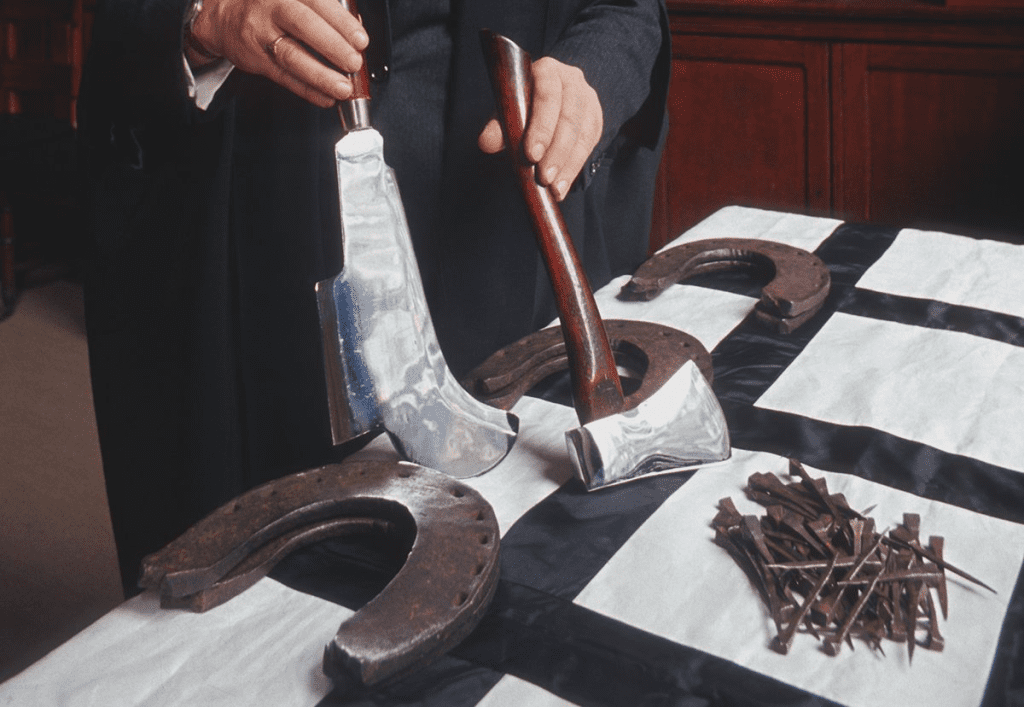A Ceremony Rooted in Mystery
Every year, in a tradition that dates back to the 13th century, the City of London performs a curious ritual. Instead of paying rent with coins or currency, the city hands over a knife, an axe, six oversized horseshoes, and 61 iron nails. These unusual items are not random oddities. They are symbolic offerings tied to properties whose exact locations have been forgotten over the centuries. And yet, the ceremony lives on proof that some medieval customs refuse to fade away.
The practice is one of the oldest continuous rituals in British history and remains one of the most puzzling. It involves the Lord Mayor of London, ancient tokens of payment, and a formal presentation to the Crown’s representative. It might sound like something out of a fantasy novel, but it’s all real, steeped in centuries of tradition and intrigue.

The Origins: Property, Power, and Fealty
Back in the medieval period, the Crown granted land or rights to cities or individuals in exchange for specific forms of tribute. These payments, known as “quit rents,” were often made not in money, but in symbolic items tokens that represented loyalty, service, or fealty to the Crown.
Video:
London Pays Rent for Invisible Land
In the case of London, two such properties were involved. The first is believed to be land near the site of present-day Chancery Lane. For this, the rent was set as one perfectly crafted knife. The second property, likely located somewhere in the neighborhood of The Moors in the eastern part of the city, came with a more complex payment: a billhook (a type of axe), six massive horseshoes, and 61 iron nails.
What makes this even more fascinating is that no one today can pinpoint exactly where these lands are. Their exact locations have long been lost to time, yet the symbolic obligation persists.
The Ceremony of Quit Rents
Each year, typically in October, the Remembrancer of the City of London one of the oldest legal offices in the world brings these symbolic items to the King’s Remembrancer, a royal official who oversees certain ceremonial functions tied to the Treasury.
The event is held in the Royal Courts of Justice and takes place with all the formalities you would expect from a centuries-old tradition. The items are inspected carefully. The knife is tested for sharpness, and the horseshoes and nails are examined to ensure they meet historical standards. Once approved, the rent is considered paid for another year.

This ceremony serves no practical purpose today, but it continues to be carried out with seriousness and respect. It’s a living link to a distant past when land ownership, royal privilege, and civic duty were intertwined in layers of ritual and symbolism.
Why It Still Matters Today
In an age where digital transactions and property taxes dominate city life, it may seem odd that anyone still delivers tools and horseshoes as rent. But traditions like this hold value far beyond economics. They connect present-day London to its medieval roots, offering a tangible reminder that even the most modern city is built on centuries of history.
Video:
Even After 800 Years |London Pay Rent To The Crown|
The ceremony also reinforces the identity of the City of London as a unique entity. Separate from Greater London, the City operates under its own governance and holds many ancient privileges. The quit rent ritual reflects this autonomy and its longstanding relationship with the Crown.
A Tradition with a Hidden Message
At its core, the rent payment ceremony reminds us of the power of continuity. While governments have risen and fallen, wars have been fought, and empires have come and gone, London still shows up every year with a blade, a hook, and a handful of nails. It’s a simple act, yet it echoes through centuries.
Though the land titles may be forgotten, and the items seem odd, the act of remembrance remains. It is a small but significant way to honor the past, preserve identity, and celebrate the enduring connection between a city and its sovereign.



